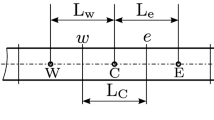Abstract
In this study, the spot welding procedures were simulated in detail using the finite element method (FEM). The stiffness matrix of any element that may reflect residual stress and residual displacement was obtained from the simulation based on calculations with the flexibility influence coefficient method. The results of static analysis on existing models and modal analysis were also compared using the spot welding elements proposed in this paper. The purpose of this study is to improve the reliability of the analysis by reflecting the residual stress of the spot welds and to design a simplified spot weld model to allow faster and more accurate analysis of structures with multiple spot welds. In analysis of structures with multiple weld points and the equivalent stiffness matrix element method for spot welds presented in this paper is expected to reduce the analysis time and produce more accurate results compared to existing analysis methods.
Similar content being viewed by others
References
Chigurupati, P., Chun, B. K., Bandar, A., and Wu, W. T., “Finite element modeling of resistance spot welding process,” International Journal of Material Forming, Vol. 3, No. pp. 991–994, 2010.
Eisazadeh, H., Hamedi, M., and Halvaee, A., “New parametric study of nugget size in resistance spot welding process using finite element method,” Materials & Design, Vol. 31, No. 1, pp. 149–157, 2010.
Bouafia, F., Boualem, S., Amin, M. M. E., and Benali, B., “3-D finite element analysis of stress concentration factor in spot-welded joints of steel: The effect of process-induced porosity,” Computational Materials Science, Vol. 50, No. 4, pp. 1450–1459, 2011.
Pan, N. and Sheppard, S., “Spot welds fatigue life prediction with cyclic strain range,” International Journal of Fatigue, Vol. 24, No. 5, pp. 519–528, 2002.
Lee, H. and Choi, J., “Overload analysis and fatigue life prediction of spot-welded specimens using an effective j-integral,” Mechanics of Materials, Vol. 37, No. 1, pp. 19–32, 2005.
Lin, P. C., Lin, S. H., and Pan, J., “Modeling of failure near spot welds in lap-shear specimens based on a plane stress rigid inclusion analysis,” Engineering Fracture Mechanics, Vol. 73, No. 15, pp. 2229–2249, 2006.
Li, B. and Fatemi, A., “An experimental investigation of deformation and fatigue behavior of coach peel riveted joints,” International Journal of Fatigue, Vol. 28, No. 1, pp. 9–18, 2006.
ANSYS, Inc., “Documentation for Release 12.0,” http://orange.engr.ucdavis.edu/Documentation12.0/ (Accessed 15 October 2013)
Guyan, R. J., “Reduction of stiffness and mass matrices,” AIAA Journal, Vol. 3, No. 2, pp. 380–380, 1965.
Alavala, C. R., “Finite element methods: Basic concepts and applications,” PHI Learning, pp. 281–282, 2008.
Gupta, P., Giridhara, G., and Gopalakrishnan, S., “Damage detection based on damage force indicator using reduced-order FE models,” International Journal for Computational Methods in Engineering Science and Mechanics, Vol. 9, No. 3, pp. 154–170, 2008.
Long, X. and Khanna, S. K., “Numerical simulation of residual stresses in a spot welded joint,” Journal of Engineering Materials and Technology, Vol. 125, No. 2, pp. 222–226, 2003.
Tsai, C. L., Dai, W. L., Dickinson, D. W., and Papritan, J. C., “Analysis and development of a real-time control methodology in resistance spot-welding,” Welding Journal, Vol. 70, No. 12, pp. S339–S351, 1991.
Babu, S. S., Reimer, B. W., Santella, M. L., and Feng, Z., “Integrated thermal-microstructure model to predict the property gradients in resistance spot steel welds,” Proc. of Sheet Metal Welding Conference, 1998.
Feng, Z., Babu, S. S., Santella, M. L., Riemer, B. W., and Gould, J. E., “An incrementally coupled electrical-thermal-mechanical model for resistance spot welding,” Proc. of 5th International Conference on Trends in Welding Research, 1998.
ANSYS Technical Support, “Resistance Spot Welding Simulation with ANSYS 7.0,” 2002.
Khanna, S. K., He, C. L., and Agrawal, H. N., “Residual stress measurement in spot welds and the effect of fatigue loading on redistribution of stresses using high sensitivity moire interferometry,” Journal of Engineering Materials and Technology, Vol. 123, No. 1, pp. 132–138, 2001.
Xu, S. and Deng, X., “An evaluation of simplified finite element models for spot-welded joints,” Finite Elements in Analysis and Design, Vol. 40, No. 9–10, pp. 1175–1194, 2004.
Choi, Y., Kim, J., Park, Y. W., and Rhee, S., “Development of a spot weld analysis model that incorporates strain rate,” Int. J. Precis. Eng. Manuf., Vol. 13, No. 2, pp. 245–251, 2012.
Author information
Authors and Affiliations
Corresponding author
Rights and permissions
About this article
Cite this article
Kim, S., Lee, W.J., Kim, K. et al. Study on the simplified numerical spot welding simulation by using the flexibility influence coefficient method. Int. J. Precis. Eng. Manuf. 14, 1961–1968 (2013). https://doi.org/10.1007/s12541-013-0267-8
Received:
Accepted:
Published:
Issue Date:
DOI: https://doi.org/10.1007/s12541-013-0267-8




